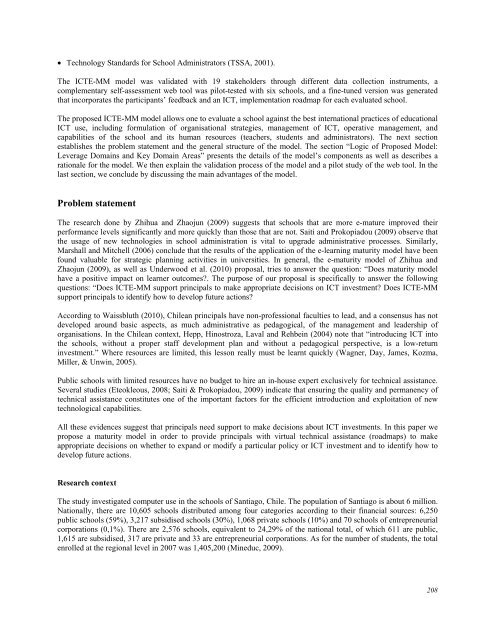A Maturity Model for Assessing the Use of ICT in School Education
A Maturity Model for Assessing the Use of ICT in School Education
A Maturity Model for Assessing the Use of ICT in School Education
Create successful ePaper yourself
Turn your PDF publications into a flip-book with our unique Google optimized e-Paper software.
Technology Standards <strong>for</strong> <strong>School</strong> Adm<strong>in</strong>istrators (TSSA, 2001).<br />
The <strong>ICT</strong>E-MM model was validated with 19 stakeholders through different data collection <strong>in</strong>struments, a<br />
complementary self-assessment web tool was pilot-tested with six schools, and a f<strong>in</strong>e-tuned version was generated<br />
that <strong>in</strong>corporates <strong>the</strong> participants’ feedback and an <strong>ICT</strong>, implementation roadmap <strong>for</strong> each evaluated school.<br />
The proposed <strong>ICT</strong>E-MM model allows one to evaluate a school aga<strong>in</strong>st <strong>the</strong> best <strong>in</strong>ternational practices <strong>of</strong> educational<br />
<strong>ICT</strong> use, <strong>in</strong>clud<strong>in</strong>g <strong>for</strong>mulation <strong>of</strong> organisational strategies, management <strong>of</strong> <strong>ICT</strong>, operative management, and<br />
capabilities <strong>of</strong> <strong>the</strong> school and its human resources (teachers, students and adm<strong>in</strong>istrators). The next section<br />
establishes <strong>the</strong> problem statement and <strong>the</strong> general structure <strong>of</strong> <strong>the</strong> model. The section “Logic <strong>of</strong> Proposed <strong>Model</strong>:<br />
Leverage Doma<strong>in</strong>s and Key Doma<strong>in</strong> Areas” presents <strong>the</strong> details <strong>of</strong> <strong>the</strong> model’s components as well as describes a<br />
rationale <strong>for</strong> <strong>the</strong> model. We <strong>the</strong>n expla<strong>in</strong> <strong>the</strong> validation process <strong>of</strong> <strong>the</strong> model and a pilot study <strong>of</strong> <strong>the</strong> web tool. In <strong>the</strong><br />
last section, we conclude by discuss<strong>in</strong>g <strong>the</strong> ma<strong>in</strong> advantages <strong>of</strong> <strong>the</strong> model.<br />
Problem statement<br />
The research done by Zhihua and Zhaojun (2009) suggests that schools that are more e-mature improved <strong>the</strong>ir<br />
per<strong>for</strong>mance levels significantly and more quickly than those that are not. Saiti and Prokopiadou (2009) observe that<br />
<strong>the</strong> usage <strong>of</strong> new technologies <strong>in</strong> school adm<strong>in</strong>istration is vital to upgrade adm<strong>in</strong>istrative processes. Similarly,<br />
Marshall and Mitchell (2006) conclude that <strong>the</strong> results <strong>of</strong> <strong>the</strong> application <strong>of</strong> <strong>the</strong> e-learn<strong>in</strong>g maturity model have been<br />
found valuable <strong>for</strong> strategic plann<strong>in</strong>g activities <strong>in</strong> universities. In general, <strong>the</strong> e-maturity model <strong>of</strong> Zhihua and<br />
Zhaojun (2009), as well as Underwood et al. (2010) proposal, tries to answer <strong>the</strong> question: “Does maturity model<br />
have a positive impact on learner outcomes?. The purpose <strong>of</strong> our proposal is specifically to answer <strong>the</strong> follow<strong>in</strong>g<br />
questions: “Does <strong>ICT</strong>E-MM support pr<strong>in</strong>cipals to make appropriate decisions on <strong>ICT</strong> <strong>in</strong>vestment? Does <strong>ICT</strong>E-MM<br />
support pr<strong>in</strong>cipals to identify how to develop future actions?<br />
Accord<strong>in</strong>g to Waissbluth (2010), Chilean pr<strong>in</strong>cipals have non-pr<strong>of</strong>essional faculties to lead, and a consensus has not<br />
developed around basic aspects, as much adm<strong>in</strong>istrative as pedagogical, <strong>of</strong> <strong>the</strong> management and leadership <strong>of</strong><br />
organisations. In <strong>the</strong> Chilean context, Hepp, H<strong>in</strong>ostroza, Laval and Rehbe<strong>in</strong> (2004) note that “<strong>in</strong>troduc<strong>in</strong>g <strong>ICT</strong> <strong>in</strong>to<br />
<strong>the</strong> schools, without a proper staff development plan and without a pedagogical perspective, is a low-return<br />
<strong>in</strong>vestment.” Where resources are limited, this lesson really must be learnt quickly (Wagner, Day, James, Kozma,<br />
Miller, & Unw<strong>in</strong>, 2005).<br />
Public schools with limited resources have no budget to hire an <strong>in</strong>-house expert exclusively <strong>for</strong> technical assistance.<br />
Several studies (Eteokleous, 2008; Saiti & Prokopiadou, 2009) <strong>in</strong>dicate that ensur<strong>in</strong>g <strong>the</strong> quality and permanency <strong>of</strong><br />
technical assistance constitutes one <strong>of</strong> <strong>the</strong> important factors <strong>for</strong> <strong>the</strong> efficient <strong>in</strong>troduction and exploitation <strong>of</strong> new<br />
technological capabilities.<br />
All <strong>the</strong>se evidences suggest that pr<strong>in</strong>cipals need support to make decisions about <strong>ICT</strong> <strong>in</strong>vestments. In this paper we<br />
propose a maturity model <strong>in</strong> order to provide pr<strong>in</strong>cipals with virtual technical assistance (roadmaps) to make<br />
appropriate decisions on whe<strong>the</strong>r to expand or modify a particular policy or <strong>ICT</strong> <strong>in</strong>vestment and to identify how to<br />
develop future actions.<br />
Research context<br />
The study <strong>in</strong>vestigated computer use <strong>in</strong> <strong>the</strong> schools <strong>of</strong> Santiago, Chile. The population <strong>of</strong> Santiago is about 6 million.<br />
Nationally, <strong>the</strong>re are 10,605 schools distributed among four categories accord<strong>in</strong>g to <strong>the</strong>ir f<strong>in</strong>ancial sources: 6,250<br />
public schools (59%), 3,217 subsidised schools (30%), 1,068 private schools (10%) and 70 schools <strong>of</strong> entrepreneurial<br />
corporations (0,1%). There are 2,576 schools, equivalent to 24,29% <strong>of</strong> <strong>the</strong> national total, <strong>of</strong> which 611 are public,<br />
1,615 are subsidised, 317 are private and 33 are entrepreneurial corporations. As <strong>for</strong> <strong>the</strong> number <strong>of</strong> students, <strong>the</strong> total<br />
enrolled at <strong>the</strong> regional level <strong>in</strong> 2007 was 1,405,200 (M<strong>in</strong>educ, 2009).<br />
208
















